Measuring the hallmarks of ageing – how can you track the underlying causes of ageing?
What consumer tests are available to check your hallmarks of ageing and how they're impacting your body?
Join the club for FREE to access the whole archive and other member benefits.
Although there is never going to be a single rejuvenation pill (nor single therapy) and we’re a long way from achieving any significant life extension, most people would like to think that a wonder-supplement exists that at least helps slow down ageing a little.
Leading the race in the anti-ageing community to be the super-supplement are NAD boosters and senolytics, with NAD boosters split into NR, NMN, NA or even NAD itself. Here I look at Tru Niagen, a patented version of nicotinamide riboside, which I tried for 2 months to see if I could notice a difference, both subjectively and objectively. I took measurements (blood and physical biomarkers) before, during and after the trial which I report on below.
| This blog is sponsored by ChromaDex. They have generously provided two month’s supply of Tru Niagen capsules. They did not request, and have not been given, any editorial input to this article. The Live Forever Club will always provide independent and unbiased information about life extension. |
Nicotinamide riboside is an alternative form of vitamin B3 that was first discovered as a growth factor for and influenza bacterium back in 1944. More recently, it has been studied as a NAD+ precursor that could slowdown the onset of age-related diseases.
For more information about NAD, and a summary of its various pathways, see What is NAD in my recent Jinfiniti NAD Test Review blog post.
Beyond its function as a NAD+ precursor, I’ve been unable to find any mechanisms that NR is involved in directly. However, given the importance of NAD+ to our metabolism, that is more than sufficient benefit as preventing the depletion of NAD+ with age has many impacts, including:
Niagen is is ChromaDex’s patent-protected form of nicotinamide riboside (NR). So, it is basically just NR, but as will all supplements and biomolecules, it is not just the ingredients on the label that counts. It is also how the substance is manufactured – both from a chemical process perspective (which affects how the body will metabolise it) and also its quality control process to ensure that you are getting what it says on the label, with no nasty contaminants. ChromaDex is audited by NSF International to check that it is following the GMP (good manufacturing process) regulations.
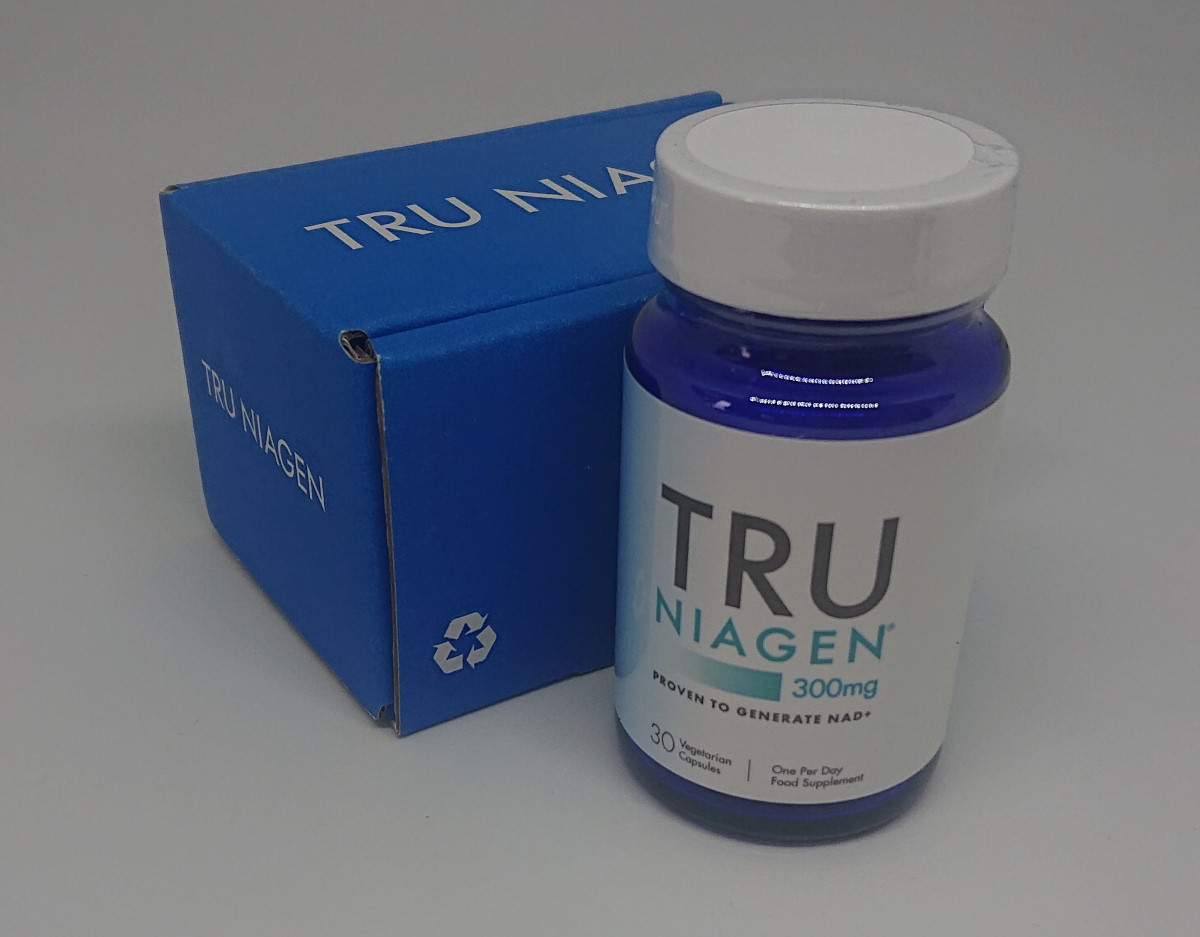
Chromadex hold several patents related to the production of nicotinamide riboside including a specific yeast strain, novel crystalline forms, and methods of preparation. They also claim that it is the world’s first and only known FDA-safety reviewed form of NR.
Whether it is radically different to other, well-prepared, NR I can’t say. However, because of its consistency it has been in used in several clinical trials that have shown it safely and effectively increases NAD+ in humans.
If you’re not keen on taking supplements, then unfortunately it is near impossible to get enough in your diet from food sources alone.
In 2019, the European Food Safety Authority (EFSA) Panel on Nutrition evaluated the safety of nicotinamide riboside chloride (i.e. Niagen) as a novel food, and as part of that concluded that “the contribution of nicotinamide riboside from food sources … is too small to be relevant for the safety assessment.” In case you’re wondering, it also concluded that Niagen is safe and bioavailable.
The only identified food source of NR was milk, but a pint contains less then 0.5 mg of nicotinamide riboside – which is about one thousandth of the recommended daily supplement dose.
I took the recommended dose of one 300mg capsule per day for 2 months, which should allow enough time for any effects to build up, and also for any weekly measurements to become statistically significant.
Unlike NMN, which is best stored in a refrigerator, NR can be stored at room temperature, and EFSA has determined that it is stable for at least 36 months at 25 degrees C.
To determine the impact of NR supplementation, and to allow a future comparison with NMN supplements, I've picked pretty much the same blood and physical biomarkers as for my NMN trial. In addition, Jinfiniti kindly donated a couple of intracellular NAD blood tests so I was able to do a before and after test for that as well.
| Biomarker | Frequency |
|---|---|
| Alanene transferase | Start + end |
| Alertness | Daily |
| Bilirubin | Start + end |
| Biological age | Start + end |
| Blood pressure | Twice weekly |
| Cholesterol ratio | Start + end |
| CRP - High sensitivity | Start + end |
| eGFR | Start + end |
| Fitness (running pace) | Twice weekly |
| Grip strength | Weekly |
| HbA1c | Start + end |
| NAD+ (intracellular) | Start + end |
| Peak flow | Weekly |
| SpO2 | Twice weekly |
| TSH | Start + end |
| Weight | Twice weekly |
| White cell count | Start + end |
The following equipment was used:
I'll provide a full update on blood biomarkers and physical measurements soon, for now I just have the result of my intracellular NAD level tests and biological age assessment.
Almost of the suggested benefits of nicotinamide riboside comes from its role as a NAD+ precursor in the NAD salvage pathway, hence a key measurement is whether my NAD+ levels increased or not.
Although Jinfiniti’s Professor Jin-Xiong She doesn’t think there is sufficient evidence of a circadian rhythm related NAD-fluctuation, as reported by some research, I thought I’d take the second test at the same time as the first one just to be safe.
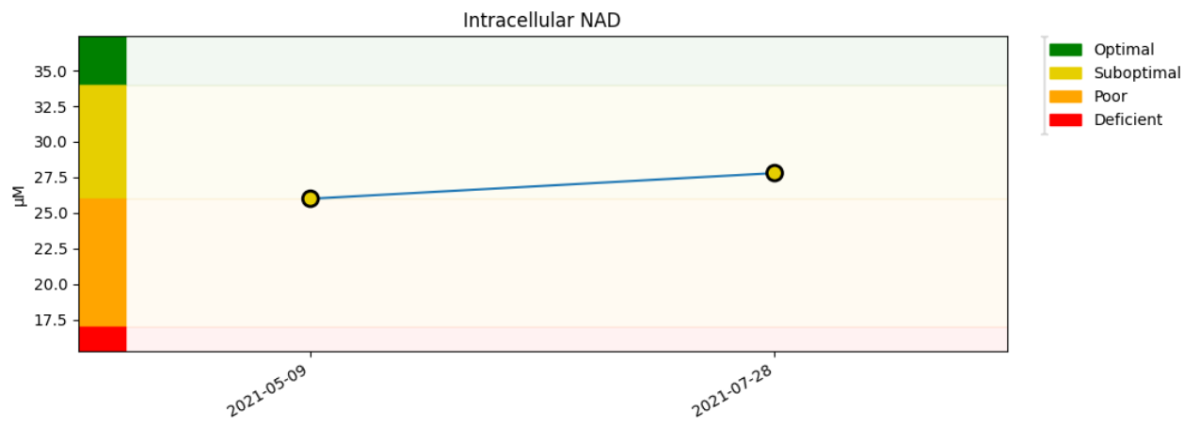
NAD level tests taken just before and just after the trial showed my intracellular NAD+ level increase from from 26.0 μM to 27.8 μM, so definitely in the right direction. It pushes me away from the border with “poor” but still very firmly at the bottom of the “sub-optimal” zone.
This is surprising given a study into the safety of NR (specifically Niagen) saw a typical increase from low-20s ug/ml to low 30s ug/ml within 2 weeks, and then maintained at that level. The increase was dose dependent with 100 mg/day rising to about 25 ug/ml and 1000 mg/day hitting 50 ug/ml.
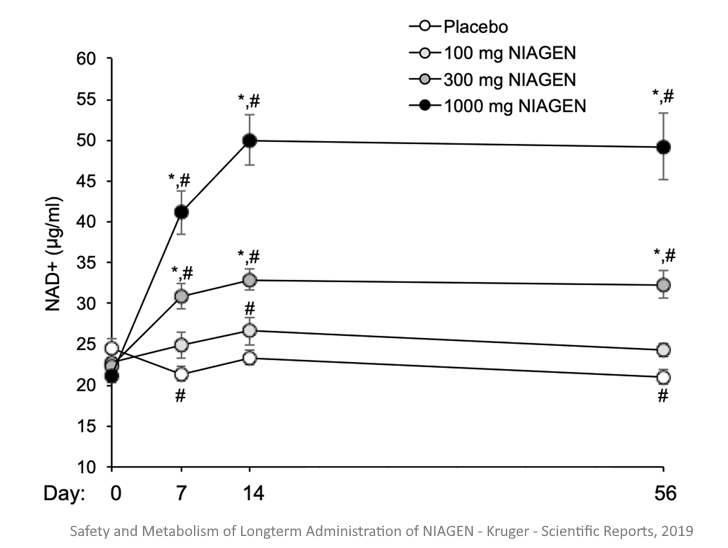
This same study determined that oral NIAGEN is safe and well-tolerated up to 1000 mg/day for 8 weeks. So, I could consider doubling my dose without any safety concerns.
I’ve recently started using Young.AI to track my biological age (full review pending) as it allows you to easily upload a blood test report and it reads all of the results automatically, then uses it to determine your biological age. I’ve upload blood panels from over 10 years ago and have seen a steady improvement from being biologically 10 years older than my chronological age, to only 5 years older last year.
Hence, I thought this combined score would be a good way to see if NR improved my body in a general way. However, unexpectedly, the “before” biological age made a big improvement jump since last year – for no obvious reason as I’ve not changed my lifestyle significantly since then. The “after” biological age then came out 3 years worse, but if I was comparing it to the previous year only then it would have looked like a positive outcome.
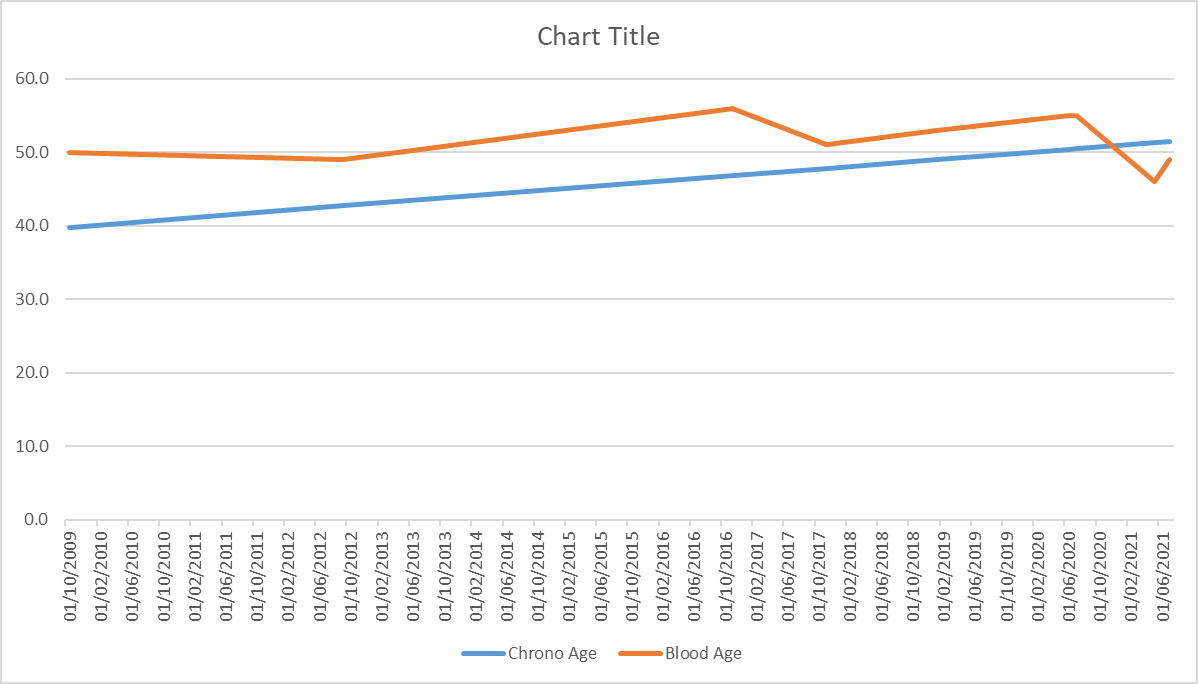
I think I’ll put this down to inconclusive – due to the unanticipated change at the beginning of the trial.
As well as the direct impact on intracellular NAD levels, I also wanted to see whether there would be an effect on a broad panel of blood biomarkers. So, I took a Medichecks* Advanced Well Man blood test the day before starting the NR supplements, and again, one day after the trial. Let's look at how some of key biomarkers responded.
| Biomarker | Start | End | Units | Normal Range | Change |
|---|---|---|---|---|---|
| Alanene transferase (ALT, or alanine transaminase) | 21 | 16 | IU/L | 10 - 50 |
|
| Bilirubin | 14 | 9 | umol/L | 0-20 |
|
| Cholesterol ratio | 2.3 | 2.5 | N/A | < 4 | |
| CRP - High sensitivity | 0.7 | 2.7 | mg/L | < 5 |
|
| HbA1c | 34 | 35 | mmol/mol | 20 - 42 | |
| eGFR | 84 | 66 | > 60 | ||
| TSH (Thyroid-stimulating hormone) | 2.37 | 1.28 | mIU/L | 0.27 - 4.2 | |
| White cell count | 4.76 | 3.50 | 10^9/L | 3 - 10 |
I’ve highlighted any that have varied more than 10% in either direction.
Alanene transferase (ALT)
ALT is an enzyme that breaks down food into energy. Normal ranges vary between labs, though generally an upper limit of normal is 40 or 50 IU/L, and males usually have slightly higher readings. Higher levels of ALT in the blood can be and indicator of liver damage, although there are other possibilities such as muscle damage.
My ALT level was already in a reasonably good place, but and has now dropped to it's lowest level since I started blood tests 12 years ago. Interestingly, the last big drop (from 28 to 19) was during my NMN trial - so perhaps NAD boosters have a big impact on the liver.
Bilirubin
Bilirubin is a byproduct of the normal breakdown of red blood cells and is eventually excreted as bile. A high level of bilirubin can indicate liver disease (or bile duct problems) as it passes through the liver which should break it down. Alternatively, it could be due to higher rate of red blood cells being broken down.
The Mayo Clinic says that low levels are usually not a concern, so a one-third drop from 14 to 9 umol/L looks like a good thing.
CRP - High sensitivity
The C-reactive protein high sensitivity blood test (hs-CRP for short) is able to monitor fluctuations in the inflammation marker, before it gets to the level of indicating an inflammatory disorder such as arthritis or inflammatory bowel disease. Although the normal range is less than 5, a value greater than 2 can suggest a higher risk of developing coronary artery disease.
A high CRP test result can also be a sign of acute inflammation, and I did feel a bit under the weather towards the end of the trial, so it could just be that I had come common cold bug (or similar) at the time. However, it is a coincidence that my CRP reading also shot up during my NMN trial - if NAD booster increase general inflammation then that would not be a good thing.
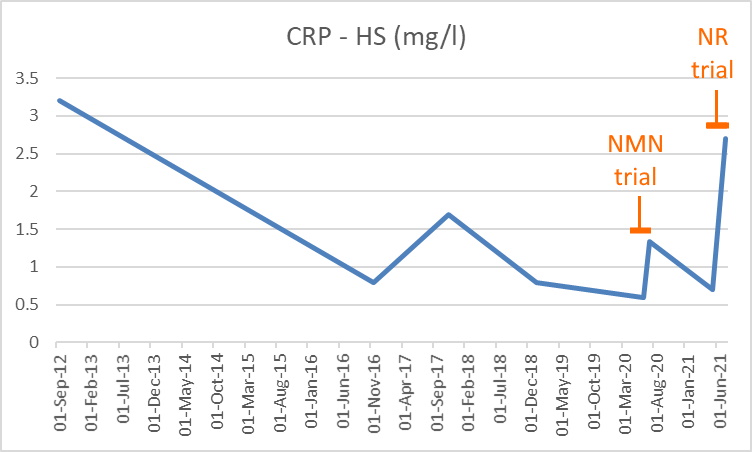
eGFR
eGFR stands for "estimated glomerular filtration rate" - that is, how much blood passes through the glomeruli (tiny filters in the kidneys) each minute - and is considered a good measure of kidney health.
During my NR trial, my eGFR result dropped 21% (from 84 to 66) and is getting very close to the lower limit of normal (60) which can indicate possible kidney disease. I had a similarly low result in 2018, so one to watch for now.
TSH (thyroid-stimulating hormone)
The thyroid is gland in the neck which produces hormones that influence many metabolic processes in the body, and affects things such as your heart rate and body temperature. However, thyroid-stimulating hormone (TSH) is produced by your pituitary gland (in the brain), and this affects how much of different thyroid hormones are produced by the thryoid. Usefully, changes in TSH can often predict problems before the actual level of thyroid hormones in the body becomes too high or low.
Thr drop from 2.37 to 1.28 mIU/L is almost half, so initially I was a bit concerned. However, (i) the lower limit of normal is 0.27 (varies slightly with age) so still safely in the normal range, and (ii) historically my TSH result has varied between 1.4 and 1.9, so it looks like the original 2.4 reading was the outlier, rather the the post-trial 1.3.
White cell count
Without doing any fancy statistical analysis – which might be difficult given the low number of data points and a single subject – my overall impression is that there was little, if any, impact on my physical biomarkers. Possibly there was a slight reduction in systolic blood pressure and weight/fat percentage – which is good. But, a more probable downwards trend in grip strength and peak expiratory flow and fitness – which is bad.
These are very different results to that observed in my NMN trial last year:
Obviously I’d need to repeat both trials a couple of times to see if the results are consistent, but if they were, that might mean that my metabolism doesn’t respond as well to NR as it does to NMN. As with many supplements, results can be very dependent on the individual, so if you’re deciding which NAD booster to take then it may well be worth trying several (with a break in between) to see how you personally respond to them.
No obvious impact – looks like normal random variation. Possibly my systolic blood pressure does not peak as high (within the noise) as it does before or after the trial, and also diastolic has its lowest readings in the middle of the trial. So maybe a minor beneficial impact, but definitely no negative impact like I saw with NMN.
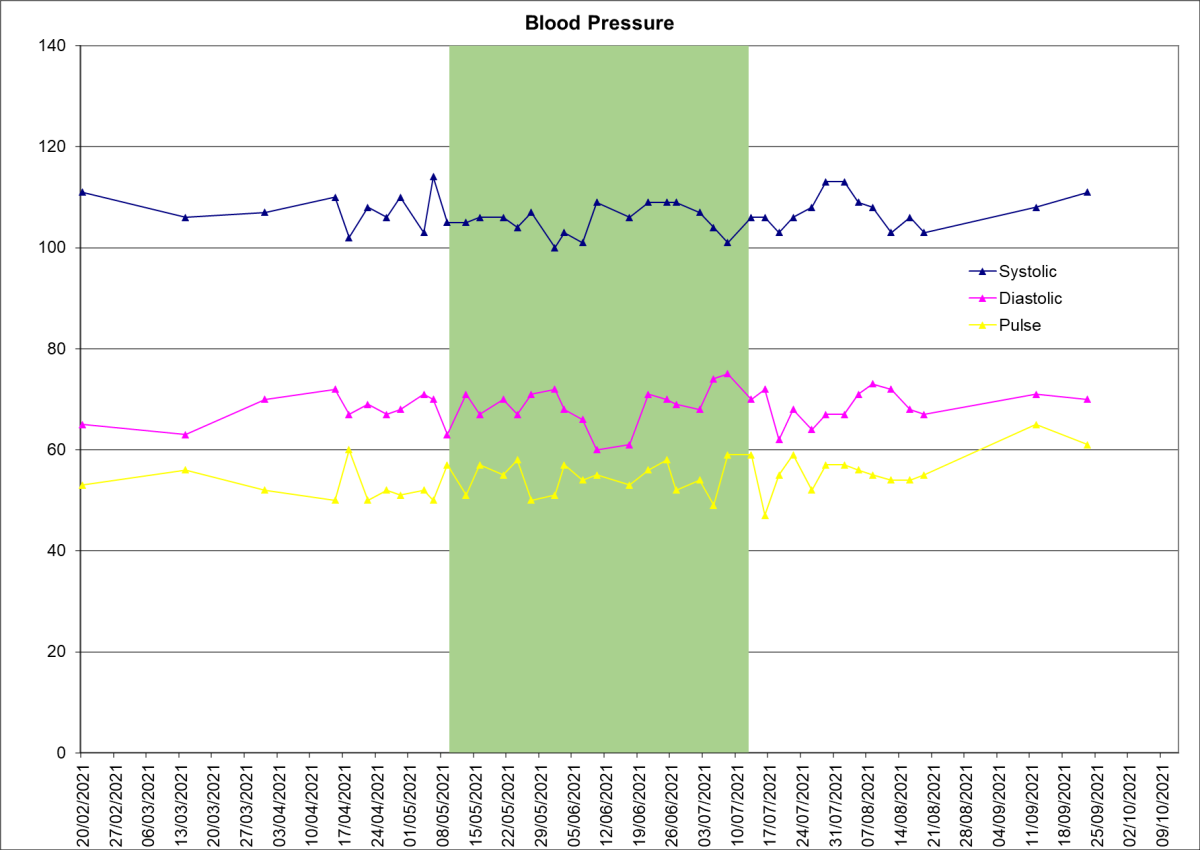
I have used my running pace as an indicator of overall fitness. I’ve been running twice a week (one short, one medium distance) for many years so generally expect to see a reasonably consistent performance. I’ve split the speed into different distances and surface type as it makes a big difference to my pace whether I’m running on roads or footpaths across fields.
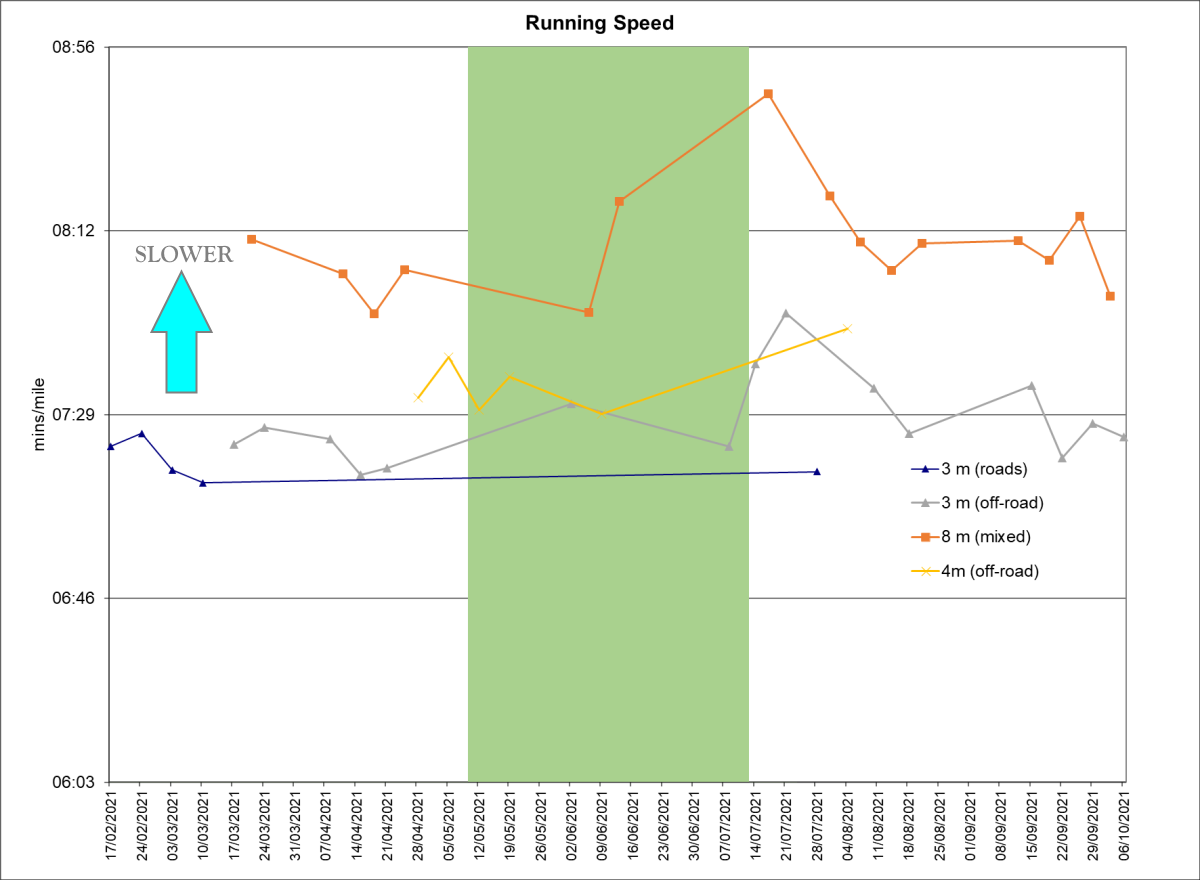
The vertical axis shows my minutes per mile pace – so the bigger the number the slower my pace. For all distances/surfaces my pace does seem to slow down for the period of the NR trial, and then for the lines that continue for several months afterwards they seem to recover again. This is very strange as I would have expected to see an improvement in muscle performance given the role of NAD+ in energy production within the body’s cells.
It was a bit of an experiment tracking grip strength, as I’ve not done it before, but I tried to follow the NHS protocol for taking measurements. Not related to the NR trial, but two things were interesting – firstly, my left hand was generally strong than my right hand, though I am right handed. Secondly, my result sits right in the middle of the “normal” range for my age – which I’m slightly disappointed about having been a regularly gym goer for my who life :(
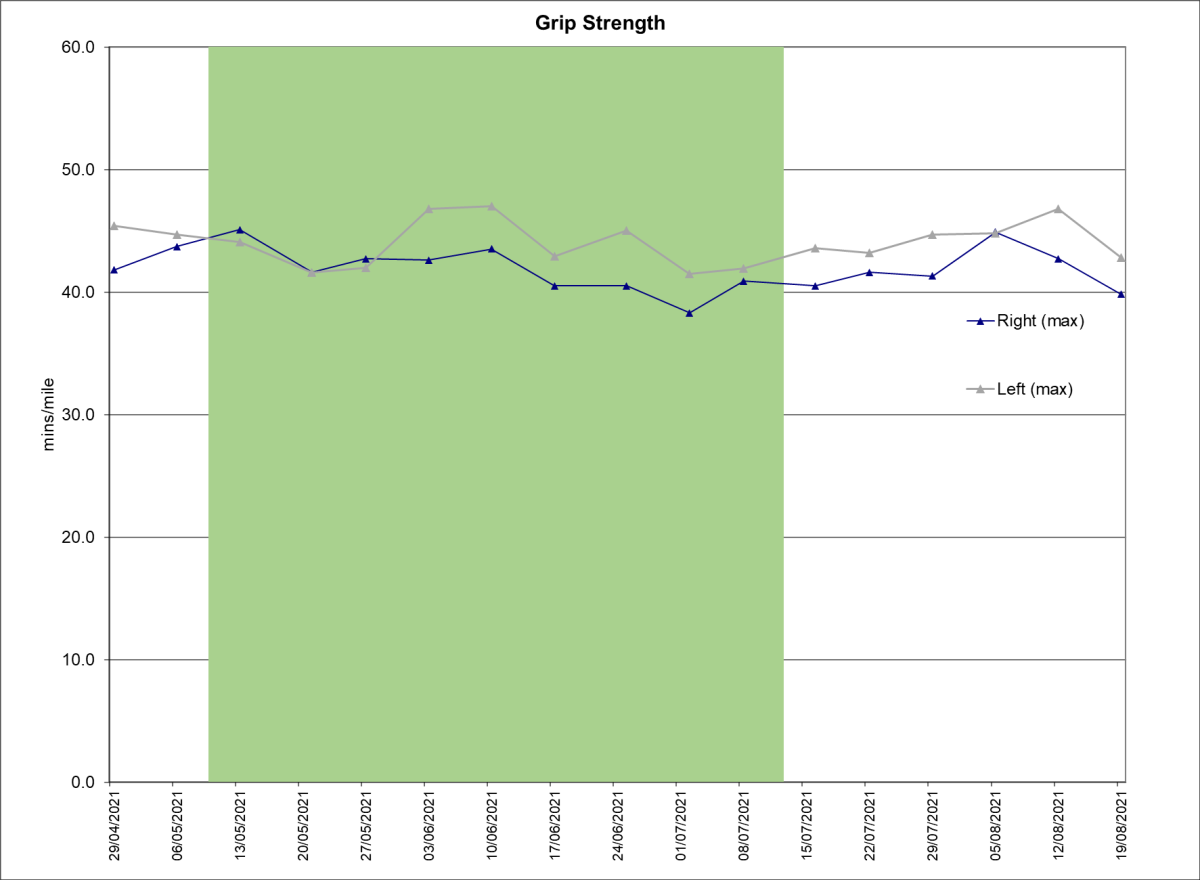
Each hand had a 7 kg difference between max and minimum result (with a result being the maximum reading of 3 attempts) with regular fluctuation between tests. Over the 2 month trial, perhaps the local average dropped from 44 kg to 42 kg, with a slight recovery towards the end. I may be projecting my assumption that I was ill for the last few weeks of the trial, so equally it could be a flatline throughout – but definitely no improvement.
The full name of this test is peak expiratory flow. It is commonly used to monitor whether airways are narrowed in asthma patients, and also acts as an index of lung function.
For my age, height and gender, I should be hitting 610 litres/minute – and before the trial was typically hitting 620 – giving me a biological age delta of about 4 years :)
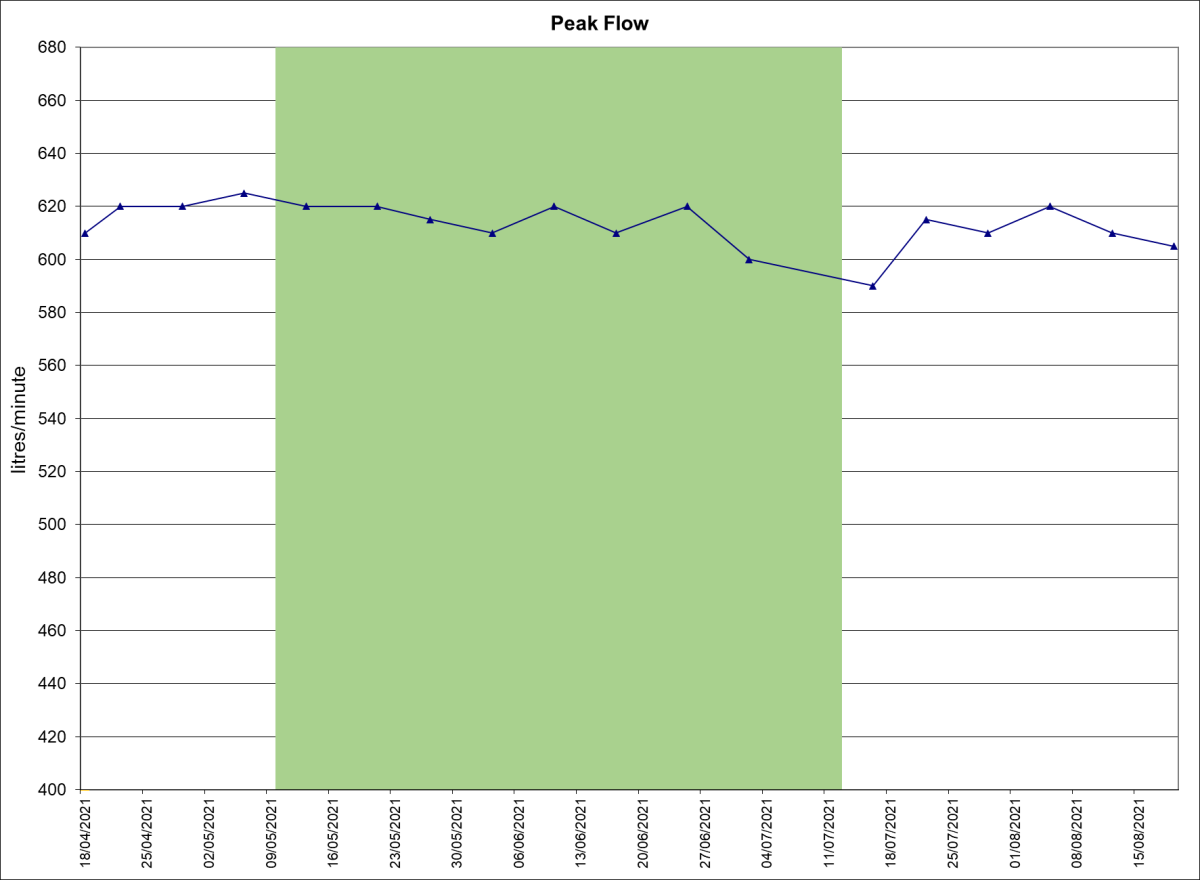
However, over the period of the trial my measurements appear to show a steady, almost straight-line decline from 620 to 600 l/m, with a recovery to 610/620 about a month afterwards.
That is slightly worrying – so will start measuring my PEF quarterly so that I have a better baseline to compare my next trial to.
A pulse oximeter is used to measure oxygen saturation level, i.e. the amount of oxygen in your blood, with the normal range (for people without COPD or other lung diseases) is 95-100%.
My SpO2 varies, quite erratically, between 95% and 99%, averaging 97% which is a bit low I think, but I’ll have to investigate that in another blog.
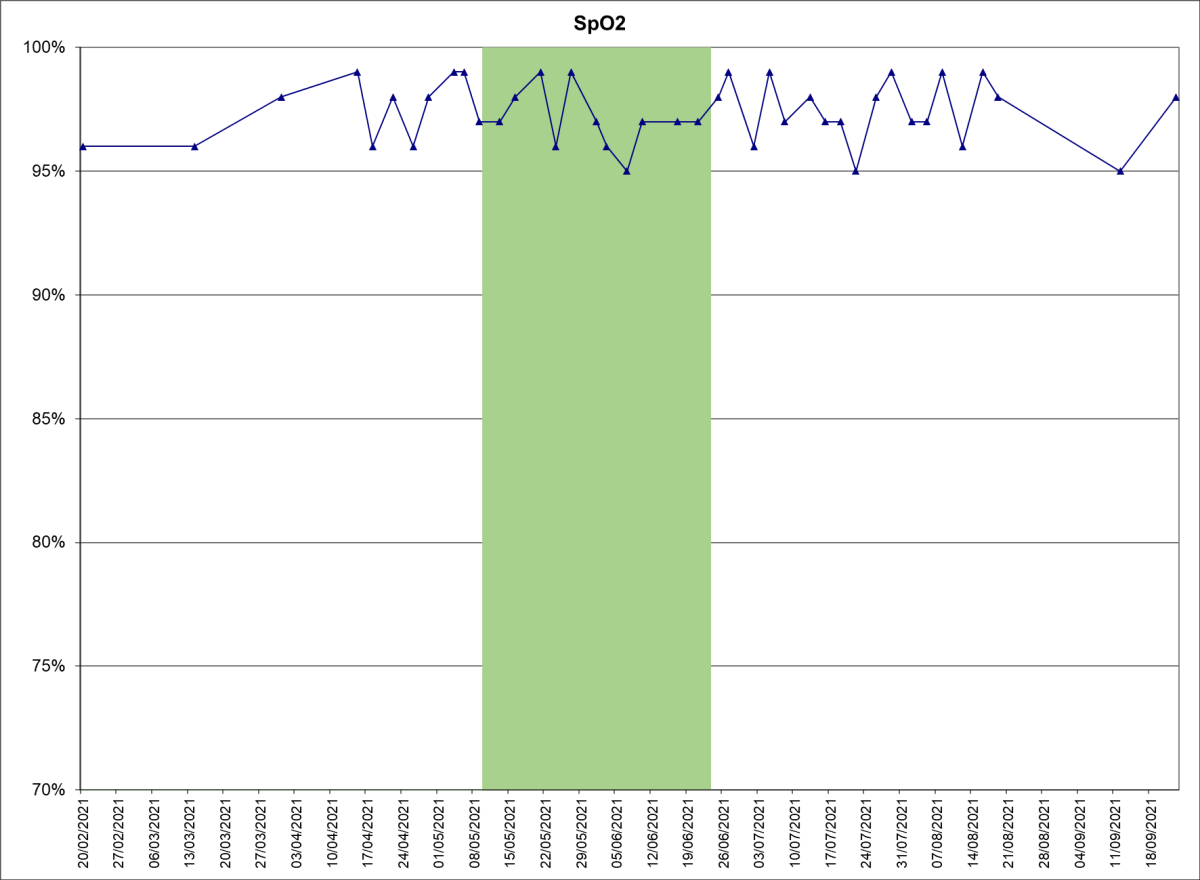
I don’t think there were any changes of note during the trial – it appears to be the same range and random variation seen before and after. Though definitely no improvement seen.
My weight doesn’t generally vary too much, and hovers around 70.5 kg before and after the NR trial, but definitely dropped by about a kilogram (to 69.5 kg) throughout the trial. It also seemed to fluctuate more, though that might just be a consequence of taking more reading during the trial period.
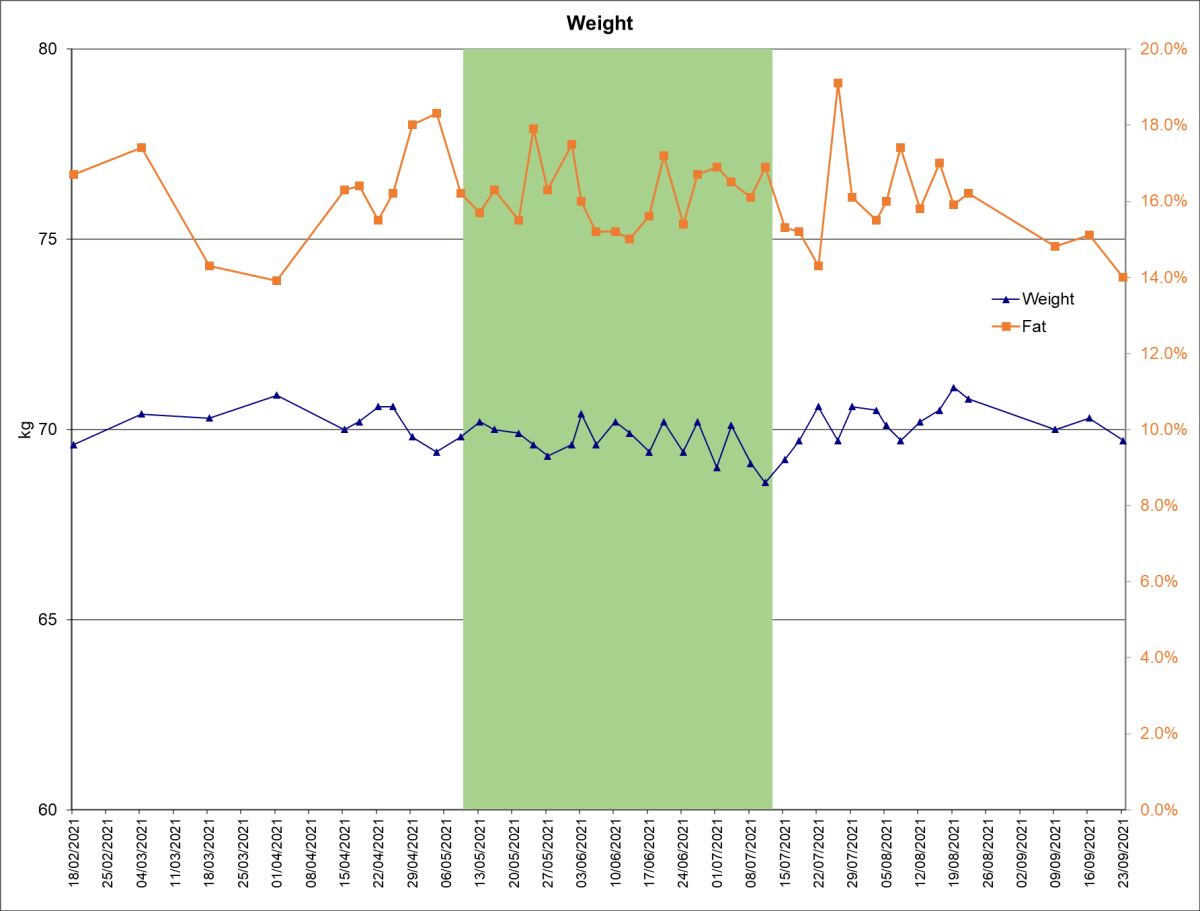
Similarly, I would say my fat percentage dropped from an average 16.5% to 16.0% and, interestingly, has continued to fall since I finished the trial.
Given the mix of positive and negative changes in blood and physical biomarkers, it's hard to know whether I will restart NR supplements. I would certainly have liked to see a bigger jump in my intracellular NAD levels.
Given the complexity of cell metabolism, and the differences seen between individuals, my first reaction is that choosing an appropriate NAD booster will be very much affected by your individual response to the various NAD pathways. The effect of which is probably best assessed by monitoring your NAD level - so perhaps, if you are looking to boost your NAD+ levels, then you'll need to try a few different supplements (perhaps even different manufacturers) to find the one that works best for you body.
Nicotinamide riboside – Wikipedia
Niagen ingredients - ChromaDex
ChromaDex NR-related patents - ChromaDex
Nicotinamide Riboside - The Current State of Research and Therapeutic Uses
Safety and Metabolism of Long-term Administration of NIAGEN (Nicotinamide Riboside Chloride) in a Randomized, Double-Blind, Placebo-controlled Clinical Trial of Healthy Overweight Adults - Scientific Reports
Safety of nicotinamide riboside chloride as a novel food pursuant to Regulation (EU) 2015/2283 and bioavailability of nicotinamide from this source, in the context of Directive 2002/46/EC – EFSA Journal, 2019
Click on resource name for more details.
Club discount available - click here
Provides at-home intracellular NAD test and other aging blood panels
An integrated global nutraceutical company devoted to improving the way people age
What Happened to Plain-Old Biology?!
TruDiagnostic TruAge Biological Age Test Review
What consumer tests are available to check your hallmarks of ageing and how they're impacting your body?
A good jump in NAD levels and grip strength during this one month trial, but not everything improved
What is the impact on physical biomarkers from taking spermidine supplements?
I try out Jinfiniti's intracellular NAD test and explain more about NAD+